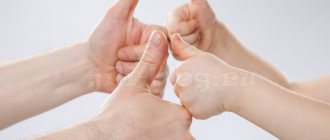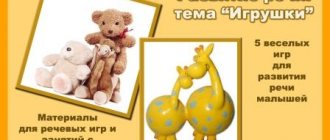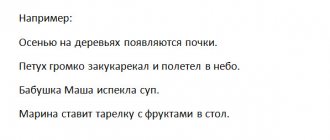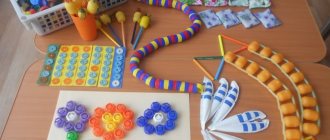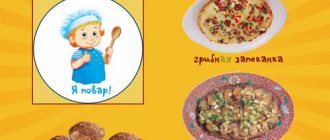Games for developing speaking skills
The basis for such games is ordinary speech. The child gains useful experience of fluent and grammatically correct spoken language. Games are useful for stimulating positive emotions if a child has isolated himself, withdrawn, or become offended.
"Skilled rhymers." It is useful to turn to such a game when you are offended by a peer, brother or sister.
Make up, make up, make up and don’t fight anymore, and if you fight, you’ll be left without a friend.
* Hey, hand, shake, shake, just don’t fight anymore.
* Relax your hand, relax and don’t pinch anymore.
* Oh, my hand is stuck! I let go of my hand and grab him by the body. You call it good, I let go of my hand.
Playful rhymes to help you overcome feelings of resentment.
Take away the insult - you are forgotten anyway,
Run into the yard, climb over the fence,
Get on your horse and ride away from me!
When you need specialist help
When a problem is discovered and the correct ways to solve it will help prevent the child from falling further behind. You need to be patient, aim for a positive result and give your child a chance to painlessly enter the social world and learn to exist in it.
Reasons to start working on speech development together with a speech therapist, neurologist and other specialists:
- after 8 months the baby does not respond to calls to him;
- a nasal voice appears;
- there is not enough air to finish a sentence;
- during a conversation there is increased salivation;
- at 2 years old the child speaks only in syllables;
- at 3 years old the child still tends to speak only in simple words;
- at 4 years old the sense of syllables has not been developed and words are distorted.
Development of a child's grammatical abilities
These games help develop children's grammatical abilities without cramming the letters of the alphabet, without the dull reading of syllables from a book.
"Let's remember the letters." Goal: to help the child remember the letters of the alphabet, relying on auditory, visual, and muscle memory.
* An adult traces the letter along the outline, naming it, and the child shades the letter with a pencil or paints it over.
* The adult draws the outlines of the intended letter in the air, the child tries to guess and name it. In a similar way, an adult draws a letter on the child’s back.
* The letter is molded from plasticine, constructed from matches, counting sticks, and seeds.
* An adult and a child take turns naming the similarity of a letter with objects from the surrounding world.
"Hide and seek with letters." Goal: to train intelligence, imagination, and the ability to recognize familiar letters in graphic contours.
A simple pattern is drawn on a sheet of paper, on sand, on asphalt. You need to look closely at it, see the outlines of letters in its lines and show them in the pattern along the contour one by one.
General Tips
In developing a child’s speech, it is important to be guided by the general principle “Do no harm.” It must be remembered that each child develops according to his own individual model and it does not always adapt to the described stages of development. We recommend adhering to principles that apply generally to the entire process of raising and developing children.
- The principle of the game form. For a preschool child, the leading activity is play. The more interesting the activity is, the more involved the child will be in it. Don't force me to play. Instead, create interest.
- The principle of mutual dialogue. Talking with children is not a waste of time, as it might seem at first glance. Bring your child into dialogue, maintain a conversation with him, tell him and listen carefully. Communication is the most effective way to teach a child to speak early.
- The principle of problem acceptance. It is difficult to admit to yourself that a child has any problems. However, the sooner you start working on mistakes, the faster you will get results. Don’t be afraid to turn to professionals if you see that independent work is not bearing fruit.
- The principle of accepting individuality. Your child is already a separate person, even if he is just starting to stand on his own two feet. You shouldn’t compare him with his peers who are already reciting rhymes with all their might. Instead of criticizing, praise every achievement of your child and then he will definitely talk.
Fun ABC lesson
This group of games helps children learn a lot of new things from the life of words, expand their vocabulary, and knowledge about language.
Ball game "Say the opposite."
Winter summer. Heat - cold. True False. Rich man - poor man. Bitter - sweet. Useful - harmful...
"The Magic Wand of the Fairy Slovarina"
To play you need a “magic” wand. One end of the stick decreases, and the other increases.
An adult player names a word, then touches one of the children with a stick. The child calls this word either diminutive or increasing, depending on the end of the stick with which the child was touched.
House - house - house. Bridge - bridge - bridge. Rain - rain - rain. Cat - cat - cat...
Author: Krugovykh Margarita Aleksandrovna
Senior teacher of MADOU d/s No. 7 in Ishim
Everyone knows what an important function breathing performs in the life of the human body. In addition to its main physiological function - gas exchange - breathing also provides such a function as speech breathing. Speech breathing (diaphragmatic) is the basis of sounding speech, the source of the formation of sounds and voices.
The mechanism of this type of breathing is inherent in us from the very beginning. This is the oldest type of breathing, inherent in all warm-blooded animals and 90% of the total need for breathing is carried out due to it.
The main muscle that powers this type of breathing is the diaphragm . It separates the abdominal and thoracic cavities. When you inhale, the diaphragm relaxes and, falling, presses on the abdominal organs, which in turn are pressed against the abdominal wall, causing it to protrude and round. As you exhale, the diaphragm contracts, compresses the lungs, and the abdominal wall retracts. In this case, the upper part of the chest remains motionless. Outwardly, it looks like belly breathing.
When correcting speech disorders, there is a need to specially organize and develop speech breathing; breathing exercises become of particular importance. The corresponding gymnastics is aimed at developing in children the skills of correct rational breathing and voluntary control of the process of air flow movement.
Consultation for parents “By playing, we develop children’s speech”
Smolina Tatyana
Consultation for parents “By playing, we develop children’s speech”
It all starts from childhood. The period of childhood occurs only once, and it is at this time that the child discovers the world of things, surrounding objects, sounds, emotions. Preschool age is a stage of active speech development . In the formation of a child's speech, , namely parents plays . developing coherent speech largely depends on how they speak to him and how much attention they pay to verbal communication with the child .
Speech , as a historically established form of communication, develops in preschool age in two directions.
Firstly, its practical use is improved in the process of communication between the child and adults and peers.
Secondly, speech becomes the basis for the restructuring of thought processes and turns into a tool of thinking.
It is known that children, even without special training, from a very early age show great interest in speech, creating new words, focusing on both the semantic and grammatical aspects of the language. But with spontaneous speech development , only a few children reach a certain level. Therefore, targeted training is necessary to create children's interest in their native language and promote the development of a creative attitude towards speech. In order to develop the speech of preschoolers on your own, it is not at all necessary to turn classes into school lessons. There are many games, simple exercises for developing speech in children , which are easy to use on the way to kindergarten, on a walk or before the child goes to bed. For these activities, use what your child sees around him: at home, on the street, in kindergarten. You can enter into its dictionary the names of not only objects, but also their parts and components. “Here’s a car, what does he have?”
-
“Steering wheel, seats, doors, wheels, engine.”
;
- “What does the tree have?”
-
“Root, trunk, branches, leaves.”
.At the age of 4-5 years, children usually learn well the names of primary colors, which means they can also be introduced to the shades of these colors
(pink, crimson, dark green, light brown, etc.)
.
When you and your child look at an object, ask him a wide variety of questions: “How big is it?
What colour? What is it made of? What is it needed for?" .You can simply ask:
“What is he like?”
, this way you encourage them to name a variety of characteristics of objects and help
the development of coherent speech . The names of the properties of objects are also reinforced in word games . Ask your child: “What is tall?”
-
“House, tree, person.”
- “What is higher - a tree or a person?
Can a person be taller than a tree? When?” Or: “What is wide?”
-
“River, street, ribbon.”
-
“What is wider - a stream or a river?”
.
This is how children learn to compare, generalize, and begin to understand the meaning of abstract words “height”
,
“width”
, etc. You can use other questions for games that help you master the properties of objects:
“What is white?
Fluffy? Cold? Hard? Smooth? Round?" .
You can play the game “What does it look like?”
.
While walking through the forest, ask him the following questions: “What does a leaf, a cloud, a shadow from a tree look like?”
. Answer yourself, but listen carefully to the child. After all, our kids have such direct thinking and perception. It is advisable to modify the game, paying more attention to the similarities of various objects:
- “How is a sheet similar to paper? (Thickness, lightness.)
What about the grass?
(In color.)
How about a drop?
(Form.)
"
The next type of exercise is pure tongue twisters. It is important that children understand that it is necessary to speak not only quickly, but also cleanly, clearly for others. Tongue twisters can be found in various children's books: “From the clatter of hooves, dust flies across the field”
,
“There is grass on the mountain, firewood on the grass
.
Children really like this exercise. Ask to pronounce the same phrase with different intonations (gently, angry, questioningly, with surprise, with joy, with fear, ordering, asking, begging, loudly, quietly): “My dear, you are not sleeping!”
;
“Did you have ice cream for breakfast?”
;
“Mom bought (buy)
grapes”;
“Hurry home!”
;
“We’ve run out of bread
.” Such tasks will help the child
develop speech , imagination, get rid of stiffness, and teach him to laugh at his mistakes without being embarrassed by his friends. It goes without saying that for the development of a preschooler’s speech it is difficult to overestimate the importance of fairy tales, poems, and other works of art. Reading works enriches a child’s vocabulary, develops his coherent speech , and teaches him to understand the figurative meaning of words. Of course, all this happens gradually. A 2-3 year old baby gradually learns to listen to text and answer adults’ questions. A child of four years of age remembers the text of a fairy tale and the sequence of actions in it almost word for word. The so-called reflected retelling helps children learn to retell. The adult begins the phrase: “Once upon a time there was a grandfather.”
, and the child finishes it:
“.
yes woman" ;adult:
"And she was with them."
,child:
".
chicken Ryaba” , etc. Then you can move on to a retelling based on the questions:
“Who did Kolobok meet?”
-
“Bunny”
-
“What song did Kolobok sing to him?”
etc.
When your child masters the ability to retell fairy tales, offer him short stories with a simple plot to retell. For example, stories by L.N. Tolstoy for children .
Children are very willing to convey the plots of cartoons, puppet shows, and circus performances when the content captures them emotionally.
Children 4-5 years old can already talk about the events of their own lives, about their personal experiences, and do this very expressively. Try giving them the creative activities below.
"Remember the incident"
Choose an event with your child that you recently participated in together. For example, how you walked along the embankment and watched the fireworks, met your grandmother at the station, celebrated a birthday. Take turns telling each other what you saw and what you did. Remember as many details as possible until you can no longer add anything to what was said.
"We speak differently"
Try to read the same children's rhyme first in a normal voice, then very quickly and very slowly, in a bass and thin voice, emphasizing the wrong words. By changing the intonation, you can read a harmless poem like a scary story or like a television report. If possible, try using a foreign accent. You never know what you can think of!
"Travel agency"
Every day you and your child go along the usual route - to the store or kindergarten. What if you try to diversify your everyday life? Imagine that you are leaving on an exciting journey. Discuss with your child what type of transport you will use , what you need to take with you, what dangers you will encounter along the way, what sights you will see. When traveling, share your impressions.
"Always at hand"
All parents are familiar with situations when it is difficult to keep a child occupied with something, for example, a long wait in line or a tiring trip on public transport. In such cases, all that is needed is for a couple of markers or at least just a pen to be found in mom’s purse. Draw faces on the baby’s fingers: one is smiling, the other is sad, the third is surprised. Let there be two characters on one hand, and, say, three on the other. The kid can give the characters names, introduce them to each other, sing a song or act out a scene with them.
"Best friend"
If you are waiting in a room where magazines are laid out, you can play "stories about your best friend"
.
Let the child choose the picture he likes. It could be a person - big or small - or an animal. Ask him to talk about his “best friend”
.
"Where does he live? What games does he like to play ?
Is he calm or does he like to run? What else can you tell about him? "Stories from pictures"
It’s good if you can pick up several pictures related to a common plot. For example, from a children's magazine (like “Funny Pictures”
). First, mix these pictures and invite your child to restore order so that they can make up a story. If your child has a hard time at first, ask a few questions. If you don’t have such a set of plot pictures at hand, just take a postcard. Ask your child what it depicts, what is happening now, what could have happened before, and what will happen later.
"Life Stories"
Children enjoy listening to stories about what happened when they were very small or when they were not in the world at all. You can tell these stories in the evening before going to bed, or you can tell them in the kitchen, when your hands are busy and your thoughts are free. What to talk about? For example, how the baby kicked his legs in your stomach when he was not yet born . Or how you learned to ride a bike. Or how dad flew on an airplane for the first time. Some stories you will have to tell more than once. Ask other family members to join the game.
"My report"
You and your child went on some trip just the two of you, without other family members. Invite him to write a report about his trip. Use photographs or videos as illustrations. Give your child the opportunity to choose what to talk about without leading questions. And you observe what exactly was deposited in his memory, what turned out to be interesting and important for him. If he starts fantasizing, don't stop. The baby’s speech develops regardless of what events, real or fictitious, are reproduced to him.
"Family Talk Show"
Maybe your child will like the idea of trying himself as a television presenter? Prepare a tape recorder or voice recorder for recording, give it to the “journalist”
pick up a microphone - and you can start an interview with your grandmother or grandfather, aunt or sister. Before the interview begins, tell your child what questions to ask. For example: “What is your favorite food?” What did you like to eat as a child? Where would you like to go?
"Change the Song"
Children like to sing about familiar things - themselves and their family, their toys and what they saw on their walks. Choose a well-known song and invite your child to come up with new words for it. It’s okay if the text is not too coherent, a lot of repetition is also not a problem. Rhymes are not required. You can offer your own, “adult”
version of the redone text.
“How did it end?”
One way to develop coherent speech can be watching cartoons. Start watching an interesting cartoon with your child, and at the most exciting part, “remember”
about an urgent matter that you must do right now, but ask your child to tell you later what will happen next in the cartoon and how it will end. Don't forget to thank your narrator!
Speech game with kids 8. Finger gymnastics based on a poem.
The poem can be used for finger gymnastics with kids. For example, do the following movements:
The first version of the finger game for kids.
The tricky saucepan cooked porridge for us. (One palm is bent in the shape of a cup, make circular movements with the finger of the other hand - as if we are interfering).
She cooked porridge for us and covered it with a handkerchief. One-two, one-two. (Cover the “saucepan” with your palm, turning your palm down/up as you count) She covered it with a handkerchief and called Vanya. Go-Go. (inviting movement) Vanyusha is coming, carrying his spoon Wow! (spread the child’s arms wide and wide)
The author of this finger gymnastics is mother, course participant Alena M.
The second version of the finger game for kids
And Elena S. Came up with another version of movements to the words of the poem:
- first and second lines - with the right hand we make clockwise rotational movements, and with the left hand we seem to be holding a pan,
- third line - make rotational movements with the left hand,
- fourth and fifth lines - with both hands we cover the pan (twice),
- sixth line - we take the pose “What is the red maiden thinking about” - the right hand on the elbow props up the cheek,
- seventh line - change hands
- eighth line - we show the index finger on our right hand, and move our left hand to the side, as if asking.
Speech game with kids 4. Showing a skit. Game in a cafe.
The author of the idea is Tatyana, the mother of little Gleb.
Speech game for little ones. Tatyana turned the nursery rhyme into a song. After each line, a simple word for a child to imitate is sung - the onomatopoeic word bulbul. Even if the baby is just starting to speak, he will already be able to sing along with you this word. And he offers to show the child a scene using lines from the verse: take a saucepan, put cereal in it, stir with a spoon, cover with a towel or handkerchief and call our toys - little animals - for breakfast. Using a spoon, we transfer the cereal from the pan into their bowls and feed all the guests our porridge.
The child can be involved in the process of transferring cereals into a pan with a large spoon or small glass, mixing water and cereals (development of fine motor skills and sensorimotor coordination).
Speech game for older children. When the child grows up and begins to speak more freely, you can turn this skit into a speech game in a cafe.
Preparing for the game: You need to come up with a name for our home cafe, draw a menu with your child (or cut and paste pictures from advertising brochures depicting products).
The child will be a cook, and the mother will be an assistant cook. The cook prepares porridge and calls everyone for lunch. He reads a poem by Nina Pikuleva, treats him to porridge, asks everyone if they liked it, whether the guests will come to the cafe again, asks to leave a review about the treat - his porridge (you need to “praise the porridge” - that is, choose figurative expressive words: what kind of porridge? Crumbly, soft, sweet, tasty, fluffy, aromatic, fragrant. Upon completion, we clean the table and wash the dishes (game actions).
Why did Tatyana introduce washing and cleaning into the game in the cafe? Because Gleb really loves to participate in them. And this is also an individual approach to the child - those actions are introduced that are significant for a particular child and which he prefers. This is very important for interaction with any baby!

